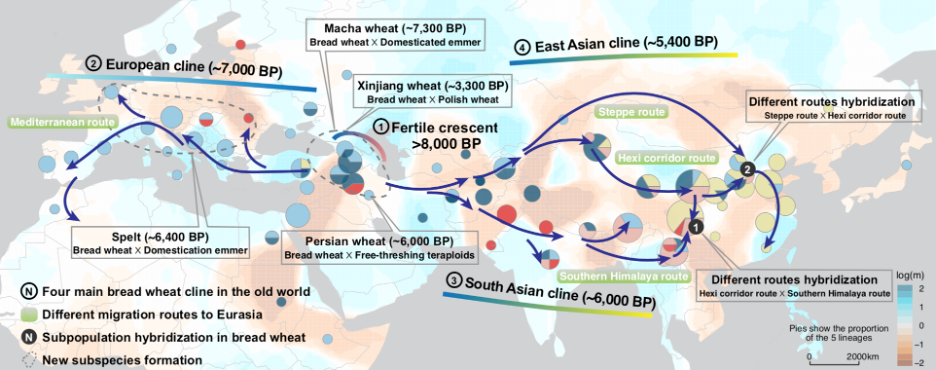Demographic modeling replaying the tape of wheat evolution
Wheat, comprising bread wheat and its relatives, is a staple food crop feeding ~35% of the global population. As one of the first ancient crops appearing in the Fertile Crescent, wheat has been cultivated for over 10,000 years since the “Neolithic Revolution” and is valued as a transforming power of human society. Despite its economic importance and intimate bond to humanity, the population history of wheat is still unclear. A new research published in Nature Plants (https://www.nature.com/articles/s41477-023-01367-3), which led by Fei Lu’s group at the Institute of Genetics and Developmental Biology, Chinese Academy of Sciences, has uncovered the evolutionary history of wheat during the Holocene.
By collecting whole-genome sequences of 795 wheat accessions from six species and 25 subspecies in the genera Triticum and Aegilops, Xuebo Zhao and Yafei Guo, along with their colleagues, constructed a genus-level genetic variation map of wheat (VMap 1.1) with ~78 million SNPs. Using demographic modeling of genomic data, they found that bread wheat originated from a polyploidization event near the southwest coast of the Caspian Sea. However, persistent gene flow from its relatives resulted in a slow speciation process of bread wheat, lasting ~3,000 years. Bread wheat then quickly spread across Eurasia and reached Europe, South Asia, and East Asia between ~7,000 and ~5,000 years ago (Fig. 1). The trans-Eurasian dispersal shaped a generally diverse but occasionally convergent adaption landscape of bread wheat—the authors found three independent loss-of-function mutations on a prime flowering time gene (Ppd-D1), which conferred early flowering phenotypes, helped bread wheat adapt to Europe, East and South Asia, respectively.

Crop relatives are valuable for breeding resilient crops during the changing climate. However, the authors identified a concerning decline in the population size of some of the most critical relatives of bread wheat, because of human dietary changes and vulnerability to future climate change. For example, the population size of diploids and tetraploids in Triticum was reduced by 82% during the last 2,000 years. This result highlighted the pressing need to protect and preserve wheat biodiversity.

In conclusion, the study provides an extensive array of demographic modeling that unravels the population history of bread wheat and its relatives and has paved the way for the effective dissection of genetic mechanisms of wheat adaptation. These findings are anticipated to support informed efforts in preserving wheat biodiversity and breeding climate-resilient crops in the future.
This work is supported by the National Natural Science Foundation of China, the Strategic Priority Research Program of the Chinese Academy of Sciences, the National Key Research and Development Program, and the Hainan Yazhou Bay Seed Lab.
